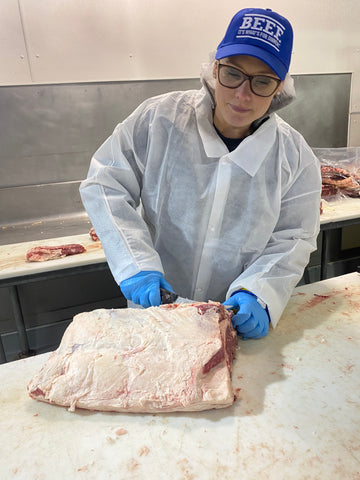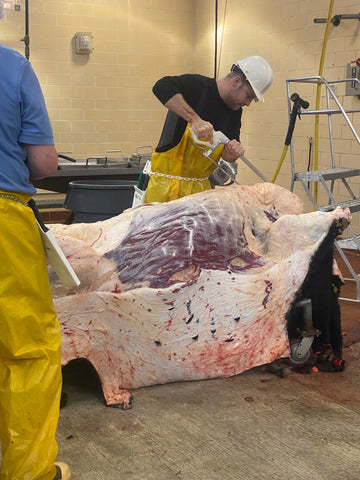Two weeks ago, I had the opportunity to attend Beef 509. It is a hands-on intensive course held at The Ohio State University taught by faculty and extension professionals - in sponsorship by the Ohio Beef Council. Although Rancher Josh and I have had a lot of experience in feedlots and in large abattoirs (processing facilities like Cargill and JBS) I had never professionally cut up a side of beef. Josh has become more of a meat butcher connoisseur as he has harvested animals on our farm for our family and yearly hog roasts.
Now, back to the beef...
Dr. Lyda Garcia is the Associate Professor of Meat Science / Extension Meat Specialist who we had the esteemed privilege of learning from. Fun fact, Josh and I have known Dr. Garcia since our time at Texas Tech during graduate school.
During the course, we watched as the animals were humanely harvested, undergoing the fascinating journey from pasture to plate.
Before delving into the requested detailed insights, I want to offer a gentle heads-up that the upcoming content may include sensitive information related to animal harvest. As a rancher committed to transparency, I aim to provide genuine insights that extend beyond what's allowed to be shared on public platforms like social media. There is so much misinformation out there from people lacking real experience and its time we set the record straight.
Having watched thousands of cattle harvested during my PhD work, this experience was not new to me. However, every time it comes with a swell of emotions. For the animal's sacrifice, the rancher that raised them and for the families who are provided nutrient dense high protein meals to sustain their families and allow them to Flourish. <--- see what I did there
To be honest, the first time you see an animal harvested it can be difficult to watch. I will leave out all the details, but these are live animals there will be blood. But after you watch, like really watch, and pay attention to the careful consideration and handling at every step you will come to an appreciation and understanding of the process. From low-stress design of how the animals enter a facility to how they are rendered unconscious before exsanguination. The entire process occurs in seconds. If you are interested in seeing inside a harvest floor check out this
link. It is by the world-renowned animal behaviorist, Dr. Temple Grandin.
Looking to learn more? Check out
this guide on Dr. Grandin’s Glass Walls Project.
You can also search for Glass Walls Project Dr. Temple Grandin and she has a whole series on processing facilities for beef, pork, lamb and chicken.
Now, back to the harvest...
After removing the hide and guts, the beef undergoes a 14-21 day dry-aging process. Picture it as nature's alchemy, where natural enzymes work their magic, tenderizing the meat and enhancing its flavor. This crucial step sets the foundation for the exceptional quality you've come to expect.
I’ll add here that this is an intricate step you will NOT find on grocery store shelves. Maybe some very high-end restaurants will serve dry-aged steaks but never ground beef. All of our beef is dry-aged, yes, including the ground beef!
Once aged, skilled butchers meticulously carve out your favorite cuts – from New York steaks to Chuck Roasts. It's a symphony of craftsmanship, transforming a massive chunk of beef into a diverse array of delectable selections. During the workshop it further solidified the need for me to have a great working relationship with my processor, which we do. The work requires a great bit of skill and knowledge. You are working in a cooler room bundled up with appropriate PPE (Personal Protective Equipment): warm coats, clean boots/shoes, hair nets, nitrile gloves and cut-resistant Kevlar gloves. Knowing how to use an extremely sharp knife and cut exactly in the right places. If you are off even a half inch it could lower your yield and turn a highly sought after steak into a pound of ground beef. Which isn’t a bad thing, but we know you love those steaks.
The final steps involve vacuum-sealing, weighing, labeling, and a quick-freeze process to ensure each cut retains its quality. It's a labor of love that culminates in delivering the finest beef straight to your table.
Check out part 2, where I delve into the science behind beef quality grades and yield grades.








Comments (0)
Back to A Rancher's Chronicle